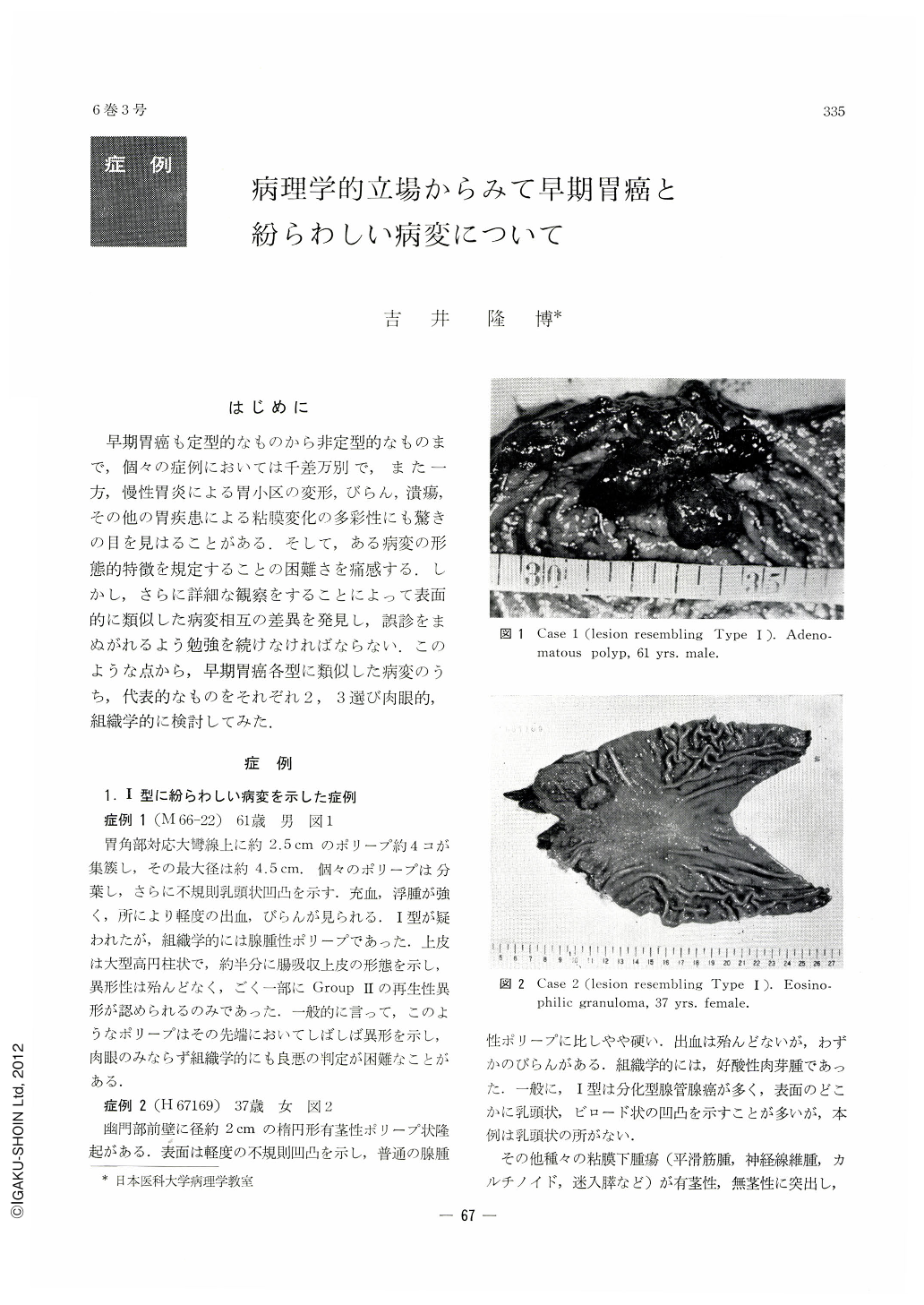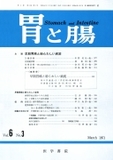Japanese
English
- 有料閲覧
- Abstract 文献概要
- 1ページ目 Look Inside
はじめに
早期胃癌も定型的なものから非定型的なものまで,個々の症例においては千差万別で,また一方,慢性胃炎による胃小区の変形,びらん,潰瘍,その他の胃疾患による粘膜変化の多彩性にも驚きの目を見はることがある.そして,ある病変の形態的特徴を規定することの困難さを痛感する.しかし,さらに詳細な観察をすることによって表面的に類似した病変相互の差異を発見し,誤診をまぬがれるよう勉強を続けなければならない.このような点から,早期胃癌各型に類似した病変のうち,代表的なものをそれぞれ2,3選び肉眼的,組織学的に検討してみた.
One or two representative cases, chosen from gastric lesions resembling various types of cancer, are discussed from macroscopical and histological stanolpoint.
Case 1 is an irregularly lobulated adenomatous polyp measuring 4.5 cm in the greatest diameter, resembling type Ⅰ early gastric cancer. Case 2 is a pedunculated polypous projection of uneven surface, measuring 2 cm in diameter, also resembling type Ⅰ. Histologically, the lesion was eosinophilic granuloma. Both Case 3 and Case 4 are mild mucosal elevations looking like type Ⅱa. Histologically, they were caused by hyperplasia of atypical mucosal epithelial cells suspected to have been formed after erosion as regenerative hyperplasia. Case 5 is a lesion suspected as type Ⅱ because of marked irregularity of the areae gastricae resulting from healing multiple erosions. Case6 concerns with a suspect of Ⅱc because of Ⅱc-like depression formed by a shallow peptic ulcer accompanied by a flat erosion. Case 7 is a lesion showing Ⅱc-like depression. Histologically, it was a healed erosion associated with marked atrophic gastritis sharply localized within the antrum.
Case 8 is a small healing ulcer having exaggerated convergency of folds noted in the fundal gland area. Such a lesion quite often simulates a small Ⅱc of the gastric body. Case 9 belongs to multicentric leiornyosarcomas resembling Ⅱa+Ⅱc scattered in the fundal gland area. This is a very rare case. Cases 10 and 11 are large, irregularly shaped “takoibo” (sucker disc of octopus) erosions resembling type Ⅱa+Ⅱc. Case 12 is a lesion showing irregular erosion accompanied by a few small sessile projections of the mucosa. It was suspected as a Ⅱc+Ⅱa of atypical type, but later proved to be tuberculous histologically. Case 14 is a lesion suspected as Ⅱc+Ⅲ, but was found to be lymphoid hyperplasia histologically. Case 15 is a healed linear ulcer looking like Ⅱc+Ⅲ. Case 16 is a peptic ulcer surrounded with a narrow zone of erosions suspicious of Case 17 shows three healed peptic ulcers located symmetrically on the anterior and posterior walls. Macroscopically they quite resemble one another. However, the lesion on the anterior wall was cancer (Ⅲ+Ⅱc) while the other two on the posterior wall were benign ulcers.

Copyright © 1971, Igaku-Shoin Ltd. All rights reserved.


